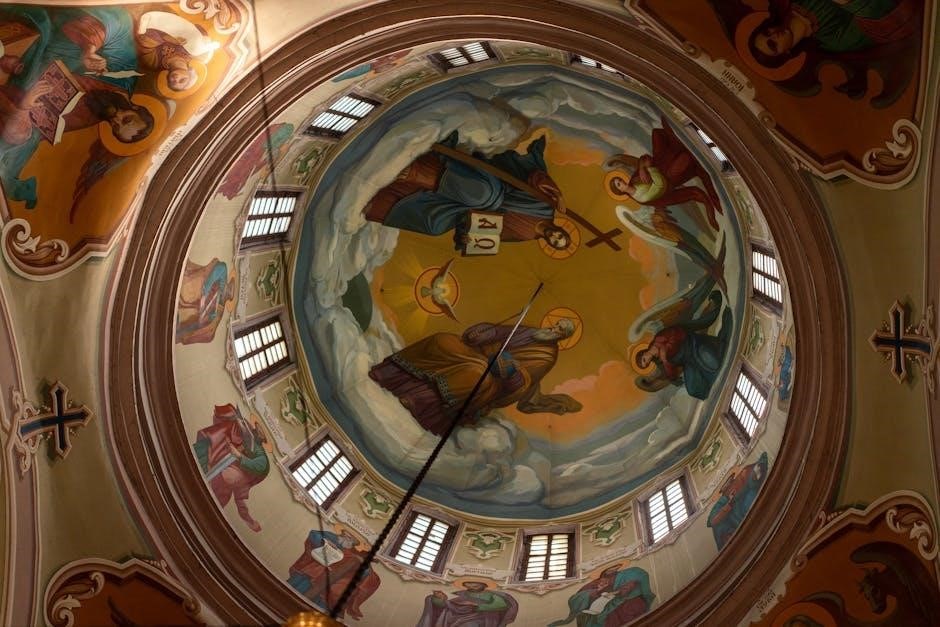Guido Reni’s St. Michael (1635) is a powerful depiction of the archangel defeating Satan, commissioned by Cardinal Sant’Onofrio for the Capuchin Church. The painting captures the dramatic struggle between good and evil, showcasing Reni’s mastery of Baroque art with its vivid contrasts and emotional depth. St; Michael, serene and strong, triumphs over a grotesque dragon-like Satan, embodying divine victory and moral virtue.
Background and Commissioning of the Painting
The painting St. Michael was commissioned in 1635 by Cardinal Sant’Onofrio, a prominent figure in the Catholic Church and brother of Pope Urban VIII. It was created for the Church of the Capuchins in Rome, specifically for the Santa Maria della Concezione dei Cappuccini. Guido Reni, a renowned Bolognese artist, was chosen for his ability to blend dramatic Baroque techniques with spiritual themes. The commission reflected the Church’s desire to depict divine triumph over evil during a tumultuous period. Interestingly, the painting is also linked to a scandal involving Reni’s dissatisfaction with Pope Innocent X, who had criticized his work, adding layers of intrigue to its creation.
The Artist’s Intent and Spiritual Message
Guido Reni’s St. Michael conveys a profound spiritual message of divine triumph and moral virtue. The artist’s intent was to depict the archangel as a symbol of unwavering strength and serenity in the face of evil. Michael’s calm expression contrasts sharply with the grotesque depiction of Satan, emphasizing the victory of good over evil. Reni’s use of light and composition underscores the spiritual hierarchy, with Michael ascending and Satan descending. This duality reinforces the painting’s allegorical purpose, inspiring viewers to reflect on their own moral struggles and the eternal conflict between light and darkness. The work serves as a visual sermon, aligning with the Counter-Reformation ideals of the Catholic Church during the 17th century.

Historical Context of the Artwork
Guido Reni’s “St. Michael” was created in the 17th century, a period of religious and artistic transformation. The painting reflects the Counter-Reformation’s emphasis on grand, emotionally charged religious art, commissioned by prominent Catholic figures like Cardinal Sant’Onofrio to inspire devotion and reinforce Church doctrine. Reni’s work became a powerful symbol of faith and moral struggle during this era, aligning with the broader cultural and religious movements of the time.
Guido Reni and His Role in Baroque Art
Guido Reni was a prominent figure in the Bolognese School, a key movement within Baroque art. His works, including St. Michael, exemplify the Baroque emphasis on dramatic compositions, intense emotions, and vivid contrasts of light and shadow. Reni’s style, characterized by elegance and harmonious proportions, bridged the classical ideals of the Renaissance with the dynamic energy of the Baroque. His ability to convey profound religious themes with emotional intensity made him a leading artist of his time, influencing numerous followers and shaping the visual language of 17th-century religious art.
The Painting’s Commission by Cardinal Sant’Onofrio
Guido Reni’s “St. Michael” was commissioned by Cardinal Sant’Onofrio, a brother of Pope Urban VIII, for the Church of the Capuchins in Rome. This commission underscored Reni’s reputation as a leading artist of his time, capable of creating works that aligned with the spiritual and artistic ideals of the Catholic Church. The cardinal’s patronage reflected the era’s practice of using art to convey religious messages and celebrate divine triumphs. Completed in 1635, the painting was intended to inspire devotion and reinforce the themes of good conquering evil, making it a significant addition to the church’s collection. The commission also highlights Reni’s ability to meet the expectations of high-ranking religious patrons.
Artistic Style and Technique
Guido Reni’s St. Michael exemplifies Baroque style with dramatic chiaroscuro, dynamic composition, and emotional intensity, capturing the archangel’s serene strength and the chaotic defiance of Satan.
Use of Light and Shadow in the Composition
Guido Reni masterfully employs chiaroscuro in St. Michael, using strong contrasts of light and shadow to create depth and drama. Light radiates from the archangel, symbolizing divine purity, while dark shadows envelop Satan, emphasizing his malevolence. The interplay of illumination and darkness highlights the dynamic tension between good and evil, drawing the viewer’s eye to the central conflict. Reni’s use of light enhances the emotional intensity of the scene, underscoring the triumph of virtue over sin. This technique, characteristic of Baroque art, elevates the painting’s narrative and spiritual impact, making it a compelling visual testament to moral struggle and divine victory.

The Iconography of St. Michael
St. Michael is traditionally depicted as a warrior archangel, symbolizing divine justice and victory over evil. His iconography often features him defeating Satan, represented as a dragon, embodying the triumph of good over evil and the protection of faith. Reni’s portrayal captures this timeless imagery, reinforcing St. Michael’s role as a celestial protector and defender of righteousness. The archangel’s strength and serenity underscore his divine mission, making him a universal symbol of hope and moral victory in religious art and culture.
The Archangel as a Symbol of Victory Over Evil
Guido Reni’s depiction of St. Michael vividly captures the archangel as a symbol of victory over evil. The painting portrays Michael standing triumphantly over a defeated dragon, representing Satan, with a serene expression that conveys divine calm and moral authority. This imagery reinforces the biblical narrative of Michael’s celestial battle, as described in the Book of Revelation, where he leads the heavenly forces to victory over the forces of darkness. The artwork emphasizes Michael’s role as a protector of faith and a champion of righteousness, embodying the universal struggle between good and evil. Reni’s masterful use of light and composition heightens the emotional impact, making the painting a powerful visual testament to the triumph of virtue over sin. The depiction not only reflects the religious beliefs of the time but also continues to inspire contemporary interpretations of moral and spiritual conflict.
Representation of St. Michael in Art History
Guido Reni’s depiction of St. Michael stands as a quintessential representation of the archangel in art history. The painting embodies the traditional portrayal of St. Michael as a strong, celestial warrior, often shown defeating Satan or a dragon. This imagery aligns with the broader artistic tradition of St; Michael as a symbol of divine justice and victory over evil. Reni’s work captures the archangel’s majesty and grace, reinforcing his role as a protector of faith and a defender of the heavens. The painting reflects the enduring cultural and religious significance of St. Michael, whose depiction has evolved across centuries while retaining core symbolic elements. Reni’s interpretation remains a celebrated example of this artistic legacy.

The Painting’s Composition and Details
Guido Reni’s St. Michael masterfully combines dynamic composition and intricate details, showcasing the archangel’s serene strength as he defeats a grotesque dragon-like Satan, blending light and shadow for dramatic effect.
St. Michael’s Attire and Weaponry
Guido Reni’s depiction of St. Michael highlights the archangel’s attire as a Roman military figure, adorned in a flowing cloak and cuirass, symbolizing strength and divine authority. His weaponry, a gleaming spear and sword, signifies his role as a warrior of God. The meticulous detail in his armor and the folds of his cloak showcase Reni’s technical skill. The contrast between the serene expression on St. Michael’s face and the ferocity of his weaponry underscores the duality of his nature as both a protector and a conqueror of evil, aligning with the Baroque tradition of dramatic yet harmonious portrayals.
The Depiction of Satan and the Dragon
In Guido Reni’s St. Michael, Satan is depicted as a dragon with a human head, symbolizing evil and chaos. The dragon’s grotesque features, including scales and wings, evoke fear and malevolence. Reni’s portrayal draws from biblical imagery, as described in the Book of Revelation, where the archangel battles the dragon. The dragon’s twisted posture and menacing expression contrast sharply with St. Michael’s calm demeanor, emphasizing the triumph of good over evil. This depiction not only underscores the spiritual struggle but also highlights Reni’s ability to convey dramatic tension through vivid and detailed characterization of both the divine and the monstrous.

Symbolism and Hidden Meanings
Guido Reni’s St. Michael carries deep symbolic meaning, with the dragon representing evil and chaos. The artwork also hints at Reni’s personal anger toward Pope Innocent X, with the dragon symbolizing the pope, adding a hidden layer of criticism to the religious narrative. This duality of meaning underscores the painting’s complexity and Reni’s ability to blend spiritual themes with personal sentiment.
Allegorical Elements in the Painting
Guido Reni’s St. Michael is rich in allegorical elements, presenting the archangel as a symbol of divine justice and victory over evil. The dragon, representing Satan, embodies chaos and moral corruption, while St. Michael’s calm demeanor signifies divine authority and righteousness. The painting also contains a personal allegory, as Reni subtly depicted the dragon with features resembling Pope Innocent X, reflecting his anger toward the pope’s criticism of his work. This layer of meaning transforms the artwork into a dual narrative, blending religious symbolism with Reni’s personal sentiments, adding depth and complexity to its interpretation. The composition thus serves as both a religious and a deeply human statement.
The Painting’s Legacy and Influence
Guido Reni’s St. Michael remains an iconic masterpiece, inspiring religious art and culture. Its dramatic portrayal of good triumphing over evil continues to captivate audiences, leaving a lasting legacy.
Its Impact on Religious Art and Culture
Guido Reni’s St. Michael has profoundly influenced religious art, becoming a cornerstone of Baroque spirituality. Its vivid depiction of good triumphing over evil resonated deeply with the faithful, inspiring countless adaptations and interpretations in art and devotion. The painting’s emotional intensity and meticulous detail set a new standard for religious iconography, making it a model for later artists. Its placement in the Capuchin Church amplified its cultural significance, transforming it into a symbol of divine victory and moral strength. Reni’s masterpiece continues to inspire awe, bridging the sacred and the artistic, and remains a powerful testament to the enduring themes of faith and redemption in religious culture.
Guido Reni’s St. Michael stands as a masterpiece of Baroque art, encapsulating the eternal struggle between good and evil. Its powerful composition and emotional depth have left an indelible mark on religious art and culture. The painting’s serene yet triumphant depiction of the archangel has inspired countless works and reinforced St. Michael’s role as a symbol of divine victory. Reni’s ability to blend dramatic lighting with intricate detail has cemented the painting’s legacy, making it a timeless icon of faith and artistic excellence. This work continues to resonate with audiences, offering a profound reflection on morality, spirituality, and the enduring triumph of light over darkness.